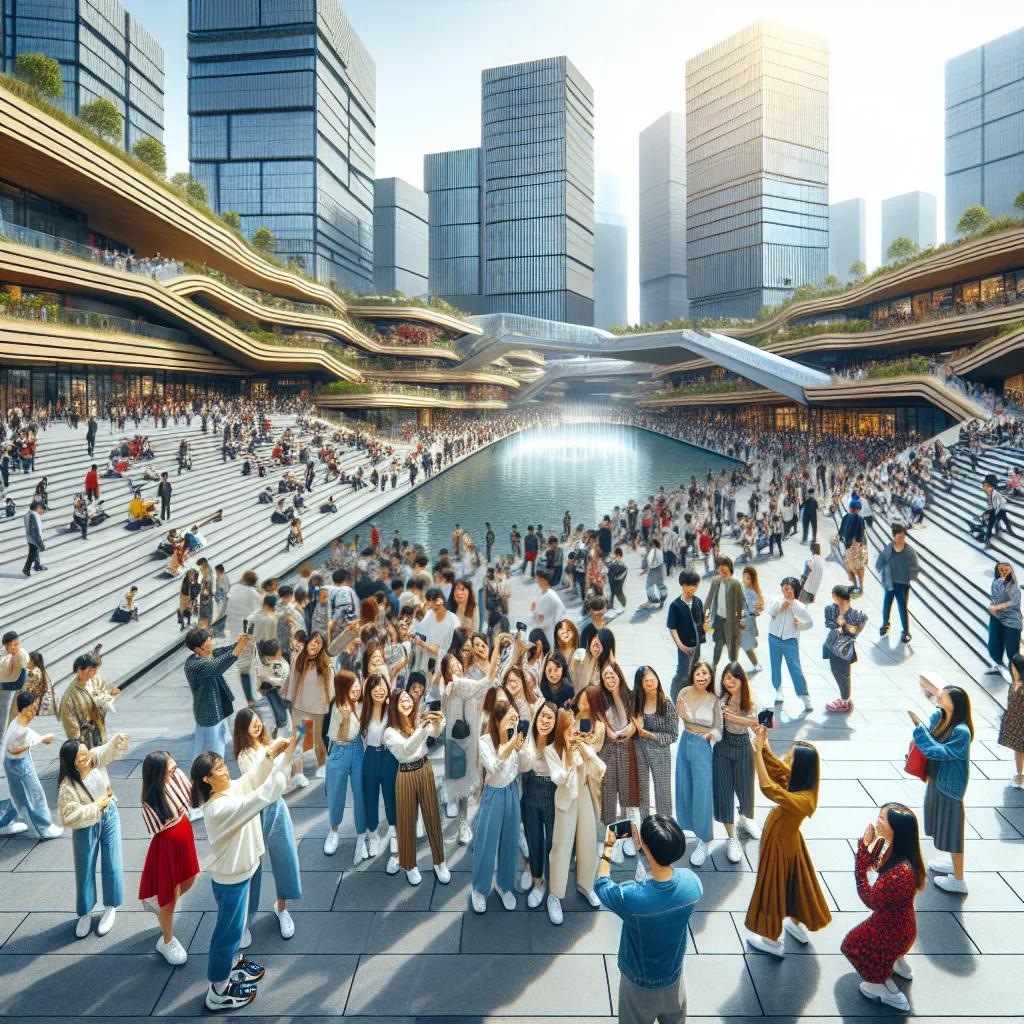The IELTS Speaking test often includes questions about places, and one common topic is describing a place that has become popular recently. This article will guide you through answering such questions effectively, helping you achieve a high band score in your IELTS Speaking exam.
Understanding the Topic
The topic “Describe a place that has become popular in recent years” is a frequent one in IELTS Speaking tests. It allows examiners to assess your ability to describe locations, express opinions, and discuss trends. This topic has appeared in various forms in past exams and is likely to continue being relevant in future tests.
 Crowded tourist destination
Crowded tourist destination
Part 1: Introduction and Interview
In Part 1, the examiner may ask general questions about popular places. Here are some possible questions and sample answers:
Sample Question 1: Do you like visiting popular places?
Band 6-7 Answer:
Yes, I do enjoy visiting popular places sometimes. They’re often famous for a good reason, and it’s exciting to see what everyone’s talking about. However, I also like finding less crowded spots.
Band 8-9 Answer:
I have a mixed feelings about visiting popular places. On one hand, they often offer unique experiences and cultural significance that make them worthwhile. However, I also value the serenity and authenticity of less frequented locations. It really depends on my mood and the purpose of my trip.
Sample Question 2: What makes a place become popular quickly?
Band 6-7 Answer:
I think social media plays a big role in making places popular quickly. When people share photos online, others want to visit too. Also, if a place is featured in a movie or TV show, it can become famous overnight.
Band 8-9 Answer:
There are several factors that can contribute to a place’s rapid rise in popularity. Social media exposure is undoubtedly a significant driver, with viral content often sparking interest in previously unknown locations. Additionally, celebrity endorsements, feature films, or TV shows can put a place on the map almost instantly. Word-of-mouth recommendations and innovative marketing campaigns can also play crucial roles in boosting a destination’s profile.
Part 2: Long Turn
In this section, you’ll be given a cue card with a topic to speak about for 1-2 minutes. Here’s a sample cue card related to our main topic:
Cue Card
Describe a place that has become popular in recent years.
You should say:
- Where it is
- How you know about this place
- What it is famous for
- And explain why you think it has become popular
Sample Answer (Band 8-9)
I’d like to talk about a place called “The Café Apartment” in Ho Chi Minh City, Vietnam, which has gained immense popularity in recent years. This unique location is situated in the heart of District 1, on Nguyen Hue Walking Street.
I first came across this place on Instagram, where numerous photos of its distinctive façade had gone viral. The building is a former residential block that has been transformed into a hub of trendy cafes, boutique shops, and co-working spaces.
What makes this place famous is its eye-catching exterior. The building’s front is a patchwork of different storefronts, each with its own unique design and color scheme. It’s like a life-sized dollhouse that has captured the imagination of both locals and tourists alike.
I believe it has become popular for several reasons. Firstly, its aesthetic appeal is perfectly suited for the Instagram age, where people are always on the lookout for photogenic locations. Secondly, it represents a creative repurposing of an old building, which resonates with the current trend of urban renewal and sustainable development. Lastly, the variety of businesses within the building offers something for everyone, from specialty coffee enthusiasts to fashion-forward shoppers.
The Café Apartment has become a symbol of Ho Chi Minh City’s rapid modernization and youthful creativity. It’s a place where history meets contemporary culture, creating a unique blend that has captivated people’s interest and made it a must-visit destination in the city.
Follow-up Questions
- Do you think this place will remain popular in the future?
Band 8-9 Answer: While it’s challenging to predict long-term trends, I believe The Café Apartment has the potential to maintain its popularity. Its unique concept and central location give it a strong foundation. However, to ensure continued success, the businesses within will need to stay innovative and adapt to changing consumer preferences. The building’s management might also need to preserve its distinctive character while addressing any infrastructure challenges that come with age.
- What are some potential downsides to a place becoming very popular?
Band 8-9 Answer: When a place gains significant popularity, it can face several challenges. Overcrowding is often the most immediate issue, which can lead to a deterioration of the visitor experience. There’s also the risk of environmental degradation, especially if the location wasn’t designed to handle large numbers of visitors. Additionally, rapid commercialization can sometimes lead to a loss of authenticity or local charm. Lastly, increased popularity often results in higher prices, which might price out local residents or change the character of the neighborhood.
Part 3: Two-way Discussion
In this part, the examiner will ask more abstract questions related to the topic. Here are some potential questions and answers:
Question 1: How do you think social media influences travel trends?
Band 6-7 Answer:
I think social media has a big impact on travel trends. People see beautiful photos of places on Instagram or Facebook and want to visit them. It can make some places very popular very quickly.
Band 8-9 Answer:
Social media has undeniably revolutionized the way we perceive and choose travel destinations. Platforms like Instagram and TikTok have the power to transform relatively unknown locations into tourist hotspots almost overnight. This digital word-of-mouth effect can be both positive and negative. On one hand, it promotes tourism and can boost local economies. On the other, it may lead to overtourism and put strain on local infrastructure and ecosystems. Moreover, the curated nature of social media posts often creates unrealistic expectations, potentially leading to disappointment when travelers encounter the reality of a destination.
Question 2: Do you think it’s better for a country to have many popular tourist spots or just a few very famous ones?
Band 6-7 Answer:
I think it’s better to have many popular spots. This way, tourists can see different parts of the country and the crowds aren’t too big in one place. It’s also good for the economy of different regions.
Band 8-9 Answer:
This is a complex issue with valid arguments on both sides. Having multiple popular tourist spots can distribute tourism revenue more evenly across a country, potentially benefiting a wider range of communities. It can also alleviate pressure on any single location, reducing the risk of overtourism and its associated problems. However, focusing on a few iconic attractions can create strong, recognizable national brands that are easier to market internationally. Ultimately, I believe a balanced approach is ideal. Countries should strive to develop and promote a diverse range of attractions while also maintaining and showcasing their most iconic sites. This strategy can cater to different types of tourists, from those seeking famous landmarks to others looking for off-the-beaten-path experiences.
Key Vocabulary and Phrases for High Scores
-
Gain popularity (phrasal verb) – /ɡeɪn ˌpɒpjəˈlærəti/ – to become liked or enjoyed by many people
Example: The small coastal town gained popularity after being featured in a hit TV series. -
Tourist hotspot (noun) – /ˈtʊərɪst hɒtspɒt/ – a place that attracts many tourists
Example: Venice has long been a tourist hotspot, known for its canals and historic architecture. -
Overcrowding (noun) – /ˌəʊvəˈkraʊdɪŋ/ – the state of having too many people or things in one place
Example: Overcrowding at popular beaches has become a major concern for local authorities. -
Authentic experience (noun phrase) – /ɔːˈθentɪk ɪkˈspɪəriəns/ – a genuine or real experience, not artificial or imitated
Example: Many travelers seek authentic experiences that allow them to immerse themselves in local cultures. -
Sustainable tourism (noun phrase) – /səˈsteɪnəbl ˈtʊərɪzəm/ – tourism that respects both local people and the traveler, cultural heritage and the environment
Example: The government is promoting sustainable tourism to protect natural resources while still benefiting the economy.
Examiner’s Advice
To achieve a high score in the IELTS Speaking test when describing popular places:
- Use a wide range of vocabulary, including less common words and idiomatic expressions.
- Demonstrate your ability to use complex grammatical structures accurately.
- Provide detailed and well-developed answers, especially in Part 2 and Part 3.
- Show your capacity to discuss abstract ideas and give opinions in Part 3.
- Maintain fluency throughout your responses, minimizing hesitations and repetitions.
- Practice describing various types of popular places to improve your versatility.
Remember, consistent practice and exposure to English will help you improve your speaking skills and confidence for the IELTS test.
For more IELTS speaking practice, you might find these related topics helpful:


